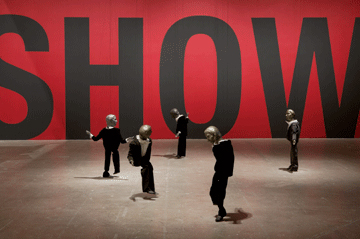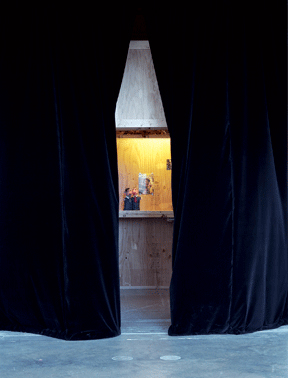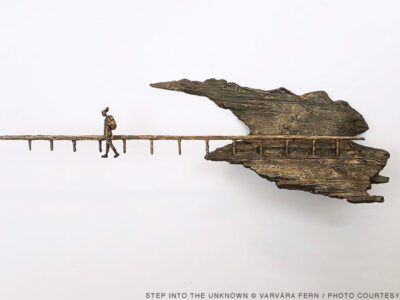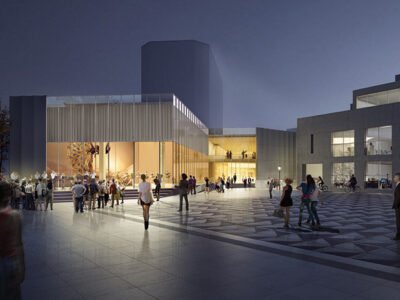
“Without master or mistress to animate it, the puppet that opens its eyes after everyone has gone to sleep is best kept to fairy tales, nightmares, and film,” writes Ingrid Schaffner, the ICA’s senior curator and co-curator of “The Puppet Show,” in the exhibition’s catalogue. “Now imagine waking up in a world full of puppets.”
That world is strange, exuberant, sometimes sinister. You enter it through what feels like the backstage door: “Puppet Storage,” Terence Gower’s installation within an installation, which is filled with puppets of all shapes and sizes and media, stored (resting? sleeping?) on rough-hewn wooden shelves. The inhabitants include shadow puppets from Indonesia, abstract puppets made from found objects, hand-puppets of Nixon and Agnew from Andy Warhol’s collection, Professor Bedlam’s Educational Punch and Judy Show, Camel Drive and Poo-Bah and Wazzir the Judge (rod puppets by Frank Ballard, who founded the graduate puppetry program and museum at the University of Connecticut), even a video filled with vintage snippets—from Lotte Reiniger’s dazzling expressionistic The Adventures of Prince Achmed, to a clip of Ed Sullivan cavorting with an Italian mouse named Topo Gigio, to the inspired hijinks of Pee-wee’s Playhouse …
Outside, the puppets come to life. Nathalie Djurberg’s disturbing latex and plasticine figures—small, soiled boy-dolls alongside a busty trollop in a spangled skirt and pink leopard-skin leggings—are creepy enough just lying there on the Storage-room shelves. But when you walk out into the main gallery and plunk yourself in front of a video titled Feed All the Hungry Children, you suddenly realize that Djurberg’s figurines have left their suspended animation and are moving about in a sequence that suggests an unholy collaboration between Red Grooms and R. Crumb, or maybe a post-feminist sequel to Lord of the Flies.

“The Puppet Show” is a stylistic cornucopia, and it’s a compliment to say that it’s kind of overwhelming. That it sometimes pushes the boundaries of taste is only fitting for an exhibition whose “historic point of departure” is Alfred Jarry’s 1896 play Ubu Roi—which, according to Schaffner and co-curator Carin Kuoni, was originally conceived as a puppet show and opened with the despotic King “roaring the French scatological word merdre” (sic).
When the exhibition “first began to percolate over 10 years ago,” notes Schaffner, it “looked to the margins of culture—to alternative performance venues, to the art history of Surrealism and the grotesque—to find its relatively idiosyncratic subject matter.”
Other videos and installations are subversive in their own ways. “This Is Not a Time for Dreaming,” a puppet opera by Pierre Huyghe and Puppet Heap about Le Corbusier’s Carpenter Center commission at Harvard, must have made that university’s administration squirm (the Dean of Deans looks like a cross between Darth Vader and a praying mantis), but it is also a surreal homage to the architect’s only building in North America.
What makes “The Puppet Show” remarkable is not just the sheer range of puppets and styles but the thought and ontological layers behind it. Among the fine essays in the catalogue, for example, are two that deal with the notion of manipulation.
Dr. John Bell, a veteran of Bread and Puppet Theater and director of the University of Connecticut’s Ballard Institute and Museum of Puppetry, notes that puppeteers frequently “describe a process of figuring out ‘what the puppet wants to do.’” That is “not a coy allusion to a mysterious power of the inanimate object” but a “pragmatic challenge” for the puppeteer to understand a puppet’s structure and discover ways to take advantage of “accidental moves and unforeseen possibilities,” he explains. “All artists realize that attempts to force materials to do exactly what you want them to do are impractical and boring.”

In “Beyond the Screen of Representation; or, When Things Begin to Move on Their Own,” John Pemberton, a professor of anthropology at Columbia University, notes that in Indonesia, the home of the legendary wayang shadow-puppet theater, “the dominant political trope is ‘Who is the puppeteer behind it all?’ Masterminds of intrigue are imagined as shadow manipulators operating dramatically behind a screen rather than pulling strings.” And yet it was only in the 1920s that “puppeteer schools” first emerged “where something called ‘manipulation’ was taught, magic spells were replaced by cultural platitudes, and the puppeteer behind the screen became an icon of artistic virtuosity,” he explains, adding:
“The wayang had been a ritual event of magical import; it was no aestheticized entertainment. Strange things followed. When clown puppets mocked colonial officials, suddenly the puppeteers were held accountable, not the puppets themselves. This amazed puppeteers accustomed to a wayang world where villagers took revenge on a story’s villain by rushing the stage mid-performance and attacking the vile puppet (not the puppeteer!) with machetes. This was a world where puppets acted on their own behalf, sometimes even performing as puppeteers … where spirit mediums were routinely possessed and this thing called a ‘puppet’ was, in fact, the very medium of that possession. A thing possessed? Residual traces of animism that Freud would call the ‘uncanny,’ a moment before the installation of representation, a moment of encounter when things begin to move on their own, or at least when a thing returns to one’s glance. How might ICA stage such an encounter?”
In a way, it already has.
—S.H.




